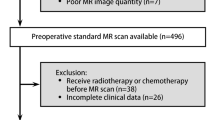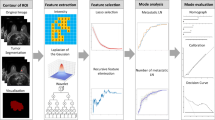Abstract
Objectives
We aimed to develop a multi-modality model to predict axillary lymph node (ALN) metastasis by combining clinical predictors with radiomic features from magnetic resonance imaging (MRI) and mammography (MMG) in breast cancer. This model might potentially eliminate unnecessary axillary surgery in cases without ALN metastasis, thereby minimizing surgery-related complications.
Methods
We retrospectively enrolled 485 breast cancer patients from two hospitals and extracted radiomics features from tumor and lymph node regions on MRI and MMG images. After feature selection, three random forest models were built using the retained features, respectively. Significant clinical factors were integrated with these radiomics models to construct a multi-modality model. The multi-modality model was compared to radiologists’ diagnoses on axillary ultrasound and MRI. It was also used to assist radiologists in making a secondary diagnosis on MRI.
Results
The multi-modality model showed superior performance with AUCs of 0.964 in the training cohort, 0.916 in the internal validation cohort, and 0.892 in the external validation cohort. It surpassed single-modality models and radiologists’ ALN diagnosis on MRI and axillary ultrasound in all validation cohorts. Additionally, the multi-modality model improved radiologists’ MRI-based ALN diagnostic ability, increasing the average accuracy from 70.70 to 78.16% for radiologist A and from 75.42 to 81.38% for radiologist B.
Conclusion
The multi-modality model can predict ALN metastasis of breast cancer accurately. Moreover, the artificial intelligence (AI) model also assisted the radiologists to improve their diagnostic ability on MRI.
Clinical relevance statement
The multi-modality model based on both MRI and mammography images allows preoperative prediction of axillary lymph node metastasis in breast cancer patients. With the assistance of the model, the diagnostic efficacy of radiologists can be further improved.
Key Points
• We developed a novel multi-modality model that combines MRI and mammography radiomics with clinical factors to accurately predict axillary lymph node (ALN) metastasis, which has not been previously reported.
• Our multi-modality model outperformed both the radiologists’ ALN diagnosis based on MRI and axillary ultrasound, as well as single-modality radiomics models based on MRI or mammography.
• The multi-modality model can serve as a potential decision support tool to improve the radiologists’ ALN diagnosis on MRI.





Similar content being viewed by others
Abbreviations
- ACC:
-
Accuracy
- AI:
-
Artificial intelligence
- ALN:
-
Axillary lymph node
- ALND:
-
Axillary lymph node dissection
- ALNM:
-
Axillary lymph node metastasis
- AUC:
-
Area under the curve
- AUS:
-
Axillary ultrasound
- DSC:
-
Dice similarity coefficient score
- HER2:
-
Human epidermal growth factor receptor 2
- HR:
-
Hormonal receptor
- ICC:
-
The intraclass correlation coefficient
- IHC:
-
Immunohistochemical
- LASSO:
-
Least absolute shrinkage and selection operator
- MMG:
-
Mammography
- MRI:
-
Magnetic resonance imaging
- NPV:
-
Negative predictive value
- PPV:
-
Positive predictive value
- SEN:
-
Sensitivity
- SLNB:
-
Sentinel lymph node biopsy
- SPE:
-
Specificity
References
Sung H, Ferlay J, Siegel RL et al (2021) Global Cancer Statistics 2020: GLOBOCAN Estimates of Incidence and Mortality Worldwide for 36 Cancers in 185 Countries. CA Cancer J Clin 71:209–249
Trapani D, Ginsburg O, Fadelu T et al (2022) Global challenges and policy solutions in breast cancer control. Cancer Treat Rev 104:102339
Tamirisa N, Thomas SM, Fayanju OM et al (2018) Axillary nodal evaluation in elderly breast cancer patients: potential effects on treatment decisions and survival. Ann Surg Oncol 25:2890–2898
Krag DN, Anderson SJ, Julian TB et al (2010) Sentinel-lymph-node resection compared with conventional axillary-lymph-node dissection in clinically node-negative patients with breast cancer: overall survival findings from the NSABP B-32 randomised phase 3 trial. Lancet Oncol 11:927–933
Chang JM, Leung JWT, Moy L, Ha SM, Moon WK (2020) Axillary nodal evaluation in breast cancer: state of the art. Radiology 295:500–515
Lee AY (2023) Nipple-sparing mastectomy in the era of neoadjuvant systemic therapy: the accuracy of preoperative MRI. Radiology 307:e223297
Lambin P, Rios-Velazquez E, Leijenaar R et al (2012) Radiomics: extracting more information from medical images using advanced feature analysis. Eur J Cancer 48:441–446
Gillies RJKP, Hricak H (2016) Radiomics: images are more than pictures, they are data. Radiology 278(2):563–577
Parekh VS, Jacobs MA (2020) Multiparametric radiomics methods for breast cancer tissue characterization using radiological imaging. Breast Cancer Res Treat 180:407–421
Wu J, Gong G, Cui Y, Li R (2016) Intratumor partitioning and texture analysis of dynamic contrast-enhanced (DCE)-MRI identifies relevant tumor subregions to predict pathological response of breast cancer to neoadjuvant chemotherapy. J Magn Reson Imaging 44:1107–1115
Shan YN, Xu W, Wang R, Wang W, Pang PP, Shen QJ (2020) A nomogram combined radiomics and kinetic curve pattern as imaging biomarker for detecting metastatic axillary lymph node in invasive breast cancer. Front Oncol 10:1463
Demircioglu A, Grueneisen J, Ingenwerth M et al (2020) A rapid volume of interest-based approach of radiomics analysis of breast MRI for tumor decoding and phenotyping of breast cancer. PLoS One 15:e0234871
Kim S, Kim MJ, Kim EK, Yoon JH, Park VY (2020) MRI radiomic features: association with disease-free survival in patients with triple-negative breast cancer. Sci Rep 10:3750
Yu Y, Tan Y, Xie C et al (2020) Development and validation of a preoperative magnetic resonance imaging radiomics-based signature to predict axillary lymph node metastasis and disease-free survival in patients with early-stage breast cancer. JAMA Netw Open 3:e2028086
Mao N, Yin P, Li Q et al (2020) Radiomics nomogram of contrast-enhanced spectral mammography for prediction of axillary lymph node metastasis in breast cancer: a multicenter study. Eur Radiol 30:6732–6739
Giuliano AE, Connolly JL, Edge SB et al (2017) Breast cancer-major changes in the American Joint Committee on Cancer eighth edition cancer staging manual. CA Cancer J Clin 67:290–303
Hammond ME, Hicks DG (2015) American Society of Clinical Oncology/College of American Pathologists Human Epidermal Growth Factor Receptor 2 Testing Clinical Practice Guideline Upcoming Modifications: Proof That Clinical Practice Guidelines Are Living Documents. Arch Pathol Lab Med 139:970–971
Wolff AC, Hammond ME, Hicks DG et al (2013) Recommendations for human epidermal growth factor receptor 2 testing in breast cancer: American Society of Clinical Oncology/College of American Pathologists clinical practice guideline update. J Clin Oncol 31:3997–4013
Kim EJ, Kim SH, Kang BJ, Choi BG, Song BJ, Choi JJ (2014) Diagnostic value of breast MRI for predicting metastatic axillary lymph nodes in breast cancer patients: diffusion-weighted MRI and conventional MRI. Magn Reson Imaging 32:1230–1236
Hyun SJ, Kim EK, Moon HJ, Yoon JH, Kim MJ (2016) Preoperative axillary lymph node evaluation in breast cancer patients by breast magnetic resonance imaging (MRI): Can breast MRI exclude advanced nodal disease? Eur Radiol 26:3865–3873
Baltzer PA, Dietzel M, Burmeister HP et al (2011) Application of MR mammography beyond local staging: is there a potential to accurately assess axillary lymph nodes? evaluation of an extended protocol in an initial prospective study. AJR Am J Roentgenol 196:W641-647
Vickers AJ, Woo S (2022) Decision curve analysis in the evaluation of radiology research. Eur Radiol 32:5787–5789
Yu Y, He Z, Ouyang J et al (2021) Magnetic resonance imaging radiomics predicts preoperative axillary lymph node metastasis to support surgical decisions and is associated with tumor microenvironment in invasive breast cancer: a machine learning, multicenter study. EBioMedicine 69:103460
Song D, Yang F, Zhang Y et al (2022) Dynamic contrast-enhanced MRI radiomics nomogram for predicting axillary lymph node metastasis in breast cancer. Cancer Imaging 22:17
Mao N, Dai Y, Lin F et al (2020) Radiomics nomogram of DCE-MRI for the prediction of axillary lymph node metastasis in breast cancer. Front Oncol 10:541849
Cui X, Wang N, Zhao Y et al (2019) Preoperative prediction of axillary lymph node metastasis in breast cancer using radiomics features of DCE-MRI. Sci Rep 9:2240
Yang J, Wang T, Yang L et al (2019) Preoperative prediction of axillary lymph node metastasis in breast cancer using mammography-based radiomics method. Sci Rep 9:4429
Alvarez S, Anorbe E, Alcorta P, Lopez F, Alonso I, Cortes J (2006) Role of sonography in the diagnosis of axillary lymph node metastases in breast cancer: a systematic review. AJR Am J Roentgenol 186:1342–1348
Li Z, Gao Y, Gong H et al (2023) Different imaging modalities for the diagnosis of axillary lymph node metastases in breast cancer: a systematic review and network meta-analysis of diagnostic test accuracy. J Magn Reson Imaging 57:1392–1403
Morawitz J, Bruckmann NM, Dietzel F et al (2021) Determining the axillary nodal status with four current imaging modalities including (18)F-FDG PET/MRI in newly diagnosed breast cancer: a comparative study using histopathology as reference standard. J Nucl Med 62:1677–1683
Guo X, Liu Z, Sun C et al (2020) Deep learning radiomics of ultrasonography: identifying the risk of axillary non-sentinel lymph node involvement in primary breast cancer. EBioMedicine 60:103018
Han L, Zhu Y, Liu Z et al (2019) Radiomic nomogram for prediction of axillary lymph node metastasis in breast cancer. Eur Radiol 29:3820–3829
Samiei S, Granzier RWY, Ibrahim A et al (2021) Dedicated axillary MRI-based radiomics analysis for the prediction of axillary lymph node metastasis in breast cancer. Cancers (Basel) 13:757
Young AT, Amara D, Bhattacharya A, Wei ML (2021) Patient and general public attitudes towards clinical artificial intelligence: a mixed methods systematic review. Lancet Digit Health 3:e599–e611
Acknowledgements
We thank all the study participants for their participation in this study, especially thanks Genji Bai, Yingyu Lin, and Cong Ding for providing technical support to the study.
Funding
The authors state that this work has not received any funding.
Author information
Authors and Affiliations
Corresponding author
Ethics declarations
Guarantor
The scientific guarantor of this publication is Genji, Bai.
Conflict of interest
The authors of this manuscript declare no relationships with any companies, whose products or services may be related to the subject matter of the article.
Statistics and biometry
No complex statistical methods were necessary for this paper.
Informed consent
Written informed consent was waived by the Institutional Review Board.
Ethical approval
Institutional Review Board approval was obtained.
Study subjects or cohorts overlap
No study subjects or cohorts have been previously reported.
Methodology
• retrospective
• diagnostic or prognostic study
• multicenter study
Additional information
Publisher's Note
Springer Nature remains neutral with regard to jurisdictional claims in published maps and institutional affiliations.
Supplementary Information
Below is the link to the electronic supplementary material.
Rights and permissions
Springer Nature or its licensor (e.g. a society or other partner) holds exclusive rights to this article under a publishing agreement with the author(s) or other rightsholder(s); author self-archiving of the accepted manuscript version of this article is solely governed by the terms of such publishing agreement and applicable law.
About this article
Cite this article
Wang, Q., Lin, Y., Ding, C. et al. Multi-modality radiomics model predicts axillary lymph node metastasis of breast cancer using MRI and mammography. Eur Radiol (2024). https://doi.org/10.1007/s00330-024-10638-2
Received:
Revised:
Accepted:
Published:
DOI: https://doi.org/10.1007/s00330-024-10638-2




